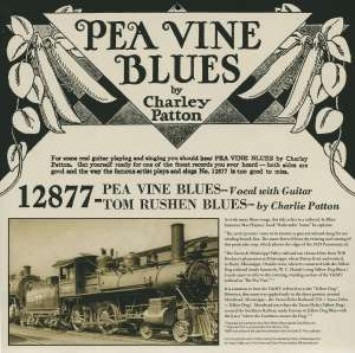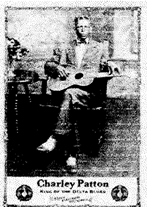
Painting © 2004 Loz
Arkle
Website
© Copyright 2000-2011 Alan White - All
Rights Reserved
Site optimised for Microsoft Internet Explorer



|
As with many blues this title refers to a railroad. In my forthcoming book Railroadin' Some, part of the text in a chapter on the Yellow Dog, runs thus: “short dog trains" and the dummy lines (Ch.2) "rickety short dogs". Writer McIlwaine, in 1948, noted that "In the Mississippi Delta these short-dog trains were so ridiculed and appreciated by the lumbermen that they nicknamed them the Black Dog; the Biggety Ben (its engineer was a pompous old coot with a yard-long beard); the Pea Vine, an all-Negro train; and the Yellow Dog, made famous by W.C. Handy.'. (4). A term such as `peavine' came to be known as general railroad slang for any winding branch line. White Mississippian Betty Carter noted that "mules by the carlot were delivered to sidings of the peavine railroads that followed the meandering contour lines through the river-built land” (5). The name derived from the twisting and turning; of this particular crop, which adorns the edges of the 1929 Paramount ad. (1) By the time he recorded Pea Vine it was part of "Patton's basic repertoire", (2)
"I think I heard the
Pea Vine when she blow. (x 2) The dark, plunging bass notes, "a somber and almost sepulchral sound" (4); pounded out in acute contrast to the forcefully picked sounds on the upper strings which sometimes `sang' the end of Charlie's vocal line. Never to more telling effect than when his harsh singing is replaced by a softer spoken tone:
"Stop your way o' livin', you
won't...; The sheer power and stark beauty of Pea Vine Blues is breathtaking in its immensity.
Pea Vine Blues continued this `local theme'. This railroad started life as two narrow-gauge lines run by entrepreneurs from Bolivar County. These were the Rosedale & Mississippi Central Valley Railroad and one run by L.V. Boyle & Co. Lumber merchant Boyle sold out to the Y. & M. V. (the Yellow Dog) in the late 1890s, which by that time had also acquired the bankrupt Rosedale railroad. The Yazoo & Mississippi Valley "refitted the line for passenger traffic and connected it to the previously acquired Rosedale line. Locals came to refer to this circuitous section of the Y. & M.V.... as "The Pea Vine" in honour of its indirect route." (7).
All the plantations that the railroad passed through had some sort of depot and freight facility. Some were flag stops and bigger plantations hired a ticket agent to live in his own accommodation at or near the depot. As Barry observed "when there were dances, a locomotive pulling one or two cars would run through the night, stopping to pick up belles or their young men at their plantations and waiting if they were not ready, delivering them to the party, delivering them home at dawn." (8). Around 1900 Will Dockery's had a depot built "which sat at the eastern end of the Pea Vine." (9). This was of course the plantation where Charlie Patton lived for a period of time. It was at the above-mentioned parties and dances where he would earn nickels and dimes and free booze playing until the crack of dawn. The route of the Pea Vine is described by Barry. (and see illustration above). "The Pea Vine route was served by a train which left Cleveland at 4.00a.m. on a two-mile run south to Boyle (Named after the lumberman). Lacking a roundhouse (that's access to a turntable for the locomotive) the Pea Vine was compelled to back its way from Boyle to Dockery's plantation depot. The train ran "head first" from Dockery's to Rosedale on the Mississippi and returned to Cleveland in the evening." (10). The whole trip covering some 60 miles.
Copyright Ó Max Haymes 2004 __________________________________________________________________________ Notes:
Discographical details from "Blues & Gospel Records 1890-1943". 4". ed. (Rev.). Robert M.W. Dixon. John Godrich. Howard Rye. Clarendon Press. Oxford. 1997. Transcriptions by Max Haymes. Discography
__________________________________________________________________________
Website © Copyright 2000-2011 Alan White. All Rights Reserved.
Check out the other essays in the "Background of
Recorded Blues" series: |





 No. 1 Pea Vine Blues -
Charlie Patton, 1929.
No. 1 Pea Vine Blues -
Charlie Patton, 1929. It
is not surprising that such a unique talent as Charlie Patton was so popular in
the Mississippi Delta. But other factors played a part in this popularity. As
well as the oft-cited `clowning' (playing the guitar behind his head, etc.) he
also employed strictly local references such as names of small towns, sheriffs,
and Delta counties. It was this sense of involvement with local communities that
endeared black (and white) audiences around Drew, Lula, and in Sharkey County,
for example. When interviewed years later, Tom Rushing (a retired Delta lawman
who had once arrested Patton) was proud of the fact Patton had featured him on
Tom Rushen Blues (sic)
in 1929. Rushing claimed to have a copy of this Paramount recording
presented by Patton in person. As Charters noted "He was one of the most "local"
singers even of the early period, when there was considerable mention of local
towns and counties in the blues. He seems to have known every small town and
plantation and sheriff and bootlegger within fifty miles of his cabin" (6).
It
is not surprising that such a unique talent as Charlie Patton was so popular in
the Mississippi Delta. But other factors played a part in this popularity. As
well as the oft-cited `clowning' (playing the guitar behind his head, etc.) he
also employed strictly local references such as names of small towns, sheriffs,
and Delta counties. It was this sense of involvement with local communities that
endeared black (and white) audiences around Drew, Lula, and in Sharkey County,
for example. When interviewed years later, Tom Rushing (a retired Delta lawman
who had once arrested Patton) was proud of the fact Patton had featured him on
Tom Rushen Blues (sic)
in 1929. Rushing claimed to have a copy of this Paramount recording
presented by Patton in person. As Charters noted "He was one of the most "local"
singers even of the early period, when there was considerable mention of local
towns and counties in the blues. He seems to have known every small town and
plantation and sheriff and bootlegger within fifty miles of his cabin" (6).
 A makeshift passenger train on the
Southern States Land & Timber Co. An Alabama logging road at Robertsdale - c.
1904. Prob. similar to early trains on the Pea Vine.
A makeshift passenger train on the
Southern States Land & Timber Co. An Alabama logging road at Robertsdale - c.
1904. Prob. similar to early trains on the Pea Vine.